|
|

Army News Service Article
A temporary plan for the discharge of male enlisted personnel to be declared surplus in the Army was announced by the War Department in Washington this week.
The plan will operate until the War Department's permanent plan for the separation of surplus personnel from the Service can be put into effect.
A temporary critical score of 85 points was established by the War Department for enlisted men of the Ground, Air, and Service Forces. Rules by which these points are acquired by an individual were also set forth by the Department.
The critical score of 85 for the temporary plan means that if any enlisted man has a score of 85 or above, he will be considered eligible for discharge by the War Department.
The score of 85 is temporary, because it will take about six weeks before critical scores for the permanent War Department Personnel Readjustment Plan can be completed.
Announcing that the plan will control priority of separation, Tompkins said, "It will apply equally to soldiers all over the world, and it embodies the desires of the soldiers themselves as expressed in polls taken by the War Department."
The program to be followed provides for issuance to each enlisted man and woman of an "Adjusted Service Rating Card." Separate point totals will be entered on the card covering each of the following four factors.
2. Overseas Credit - One point for each month served overseas since Sept. 16, 1940.
3. Combat Credit - Five points for the first and each additional award of the following for service performed since Sept. 16, 1940: Distinguished Service Cross, Legion of Merit, Silver Star, Distinguished Flying Cross, Soldier's Medal, Bronze Star Medal, Air Medal, Purple Heart, and Bronze Service Stars (Battle Participation Stars).
Credit also will be given for those awards and decorations of a foreign country which may be accepted and worn under War Department regulations in effect when the Readjustment Regulations are placed in operation.
4. Parenthood Credit - Twelve points for each child under 18 years up to a limit of three children.
"To illustrate how the point system works, let us suppose that a soldier has been in the Army 36 months, has served overseas for 18 months, has won the Silver Star and Purple Heart, has participated in three major campaigns, and is the father of a child under 18. He would receive 36 points in Service Credit, 18 points in Overseas Credit, 25 points in Combat Credit, and 12 points in Parenthood Credit. His total score would be 91 points," Tompkins declared.
Men with the highest point totals will become eligible for release from the Army except where considerations of military necessity make it impossible to let them go until qualified replacements can be obtained, Tompkin's statement said.
This exception applies particularly to men possessing special skills required during the war against Japan and to men in units that will have to move into the Pacific so swiftly that no opportunity is provided for replacing men with high scores until they reach the new theater.
"The Army wants to be absolutely certain, however, that any such cases which arise represent true military necessity and not military convenience. Therefore, all Theaters have been instructed to establish a reviewing authority at an appropriate level to consist of selected, mature officers who will pass on every case where an individual with a score equal to or above the critical score is to be retained by reason of military necessity," Tompkins revealed.
"I know many of you are wondering," Tompkins said, "how we know whether the point credits we intend to use will actually achieve the desired effect of permitting those soldiers who have seen the longest and most arduous service away from home and those with children to leave the Army first.
"A preliminary survey made by the War Department on the basis of one-sixth demobilization of the Army indicates that all but two percent of the men to be released will be men who have served overseas and that these two percent will be fathers who have been in the Army a long time.
"The significance of these figures becomes clearer when you consider that 68 men out of every hundred now serving in the Army have served overseas; whereas 98 out of every hundred to be returned to civilian life will be overseas veterans.
"Men who have been in combat constitute 35 percent of the Army but 73 percent of the men who will get out are from this group. Putting it another way, men with combat experience make up a little over one-third of the Army, but constitute nearly three-quarters of the number to be released.
"Fathers represent 19 percent of the Army and 26 percent of the group returning to civilian life. In other words, one soldier out of five is a father, but one man in every four to be sent home will be a father.
"Since we did not begin drafting fathers until the war was well advanced, it is apparent that our system is operating heavily in their favor," Tompkins explained.
The War Department statement declared that after Adjusted Service Rating Cards have been filled out, the number of soldiers with each of their point totals will be reported to the Adjutant General's Office in Washington, where a certain point total will be established as a critical score.
This critical score represents the minimum number of points with which an enlisted man or woman can be released from the Army. There will be one critical score for all enlisted men in the Army Ground and Service Forces, and another for all men in the Army Air Forces.
The third critical score will be for members of the Woman's Army Corps.
These critical scores are designed to assure equality of treatment for enlisted personnel in all branches of the Service. The interim score of 85 points has been established pending the compilation and all soldiers with 85 points or more will be considered as eligible for release in accordance with the plan.
Men will start moving to separation centers "for discharge early next week," the War Department statement said.
The interim score for members of the Woman's Army Corps will be 44, Army News Service quoted the War Department as stating.
Only points scored as of Saturday, May 12, 1945, will be taken into consideration in determining eligibility for release.
The only credits which will be given after that date will be for decorations and battle participation stars earned "prior thereto." Likewise, additional credit will be given for children born on or before May 12, but whose birth was not known to the father at the time scores were prepared.
Because of war needs, Tompkins' statement declared, the initial rate of release will be more rapid among ground troops than among those assigned to the Air and Service Forces. However, through transfers of some low-score men from the Ground Forces and new trainees, a proportionate share of the men will be released from all three forces as rapidly as practicable, Tompkins' statement declared.
Although officers will have an adjusted service rating score based on the same multiples as enlisted personnel, this will be secondary to the prime requirement of military necessity, the statement continued.
"I would like to explain the method we will use in releasing officers," Tompkins said. "It is tougher than the plan for enlisted personnel primarily because officers have received additional training, have heavier responsibilities, and have developed specialized skills and leadership capacity.
"They must be handled more on an individual than a group basis."
"The expression, 'military necessity,' as applied to officers means consideration must be given on an individual basis to the relative utility of an officer, need for his specialty, and the availability of assignments which will make the best use of his capabilities.
"Officers with lengthy
|
The War Department said that the carrying-out of the partial demobilization program will not affect the continued release of men over 42, if they make application without regard to other factors.
Holders of the Congressional Medal of Honor, with the exception of Regular Army officers, will be discharged from the Service upon their request. This action of the War Department affects 82 winners of the award now serving in the Army. Four others are missing in action.
Under the War Department partial demobilization plan, when individuals declared surplus in overseas theaters arrive in the United States, they will proceed from ports to reception stations close to their homes.
In the reception stations, those individuals with scores equal to or above the critical score will be screened once more to determine whether they are essential to the Army as a whole or are non-essential and can, therefore, be returned to civilian life.
An enlisted man will be held at this point as essential to the Army only if his skill is so important to the Army and so scarce that he cannot be spared. Individuals who are found non-essential at the reception station immediately will be transferred to the separation center located at the same post for processing for release from the Army.
The complete process in the separation center will take about 48 hours.
RE-DEPLOYMENT HAS STARTED
Re-deployment of U.S. troops from Italian and French ports to the Pacific has already started, according to the statements from Army officials this week.
Gen. Joseph McNarney, Deputy Supreme Commander of the Mediterranean Theater, gave the first confirmation that combat troops are en route to the Orient.
From France, Gen. Ike Eisenhower's SHAEF headquarters stated service units are headed for the Japanese war. But concerning combat troops, it was declared there it would be "not much under six months" before they would be likely to reach the Pacific.
These combat troops will have an eight-week training campaign on Japanese tactics, equipment, and uniforms in France and Germany under a senior, experienced battle general whose name cannot be revealed.
He is expected to have the assistance of a number of Gen. Douglas MacArthur's junior officers. Japanese equipment also will be sent to Europe.
Dispatches quoted Gen. Ike Eisenhower as saying that a letter had been sent to all senior commanders containing a guarantee that veterans who fought in both North Africa and Europe would not be sent to the Pacific. Five divisions were mentioned, First Infantry, First Armored, Ninth, 34th, and Third Infantry, as being eligible.
In the Pacific, Lt. Gen. Barney Giles, the Commanding General of the USAAF for that ocean area, stated that more bombs than hit Germany would rain on Japan.
Lt. Gen. James Doolittle, head of the Eighth Air Force in Europe, gave an idea of the awesome number of planes available to the U.S. by telling the press that his Air Force alone had over 2,400 B-24's and B-17's. These types will be used as medium bombers to supplement the B-29's in the Pacific.
Doolittle said plans were underway to shift part of the Eighth to the Pacific, with the rest being sent to the U.S. or used for occupational duty.
Gen. Brehon Somervell, head of SOS, gave a breakdown of ETO re-deployment for the months to come. He said the Army plans to withdraw 3,100,000 personnel from Europe at the rate of 25,000 to 300,000 a month. He said about 400,000 will be left for occupational duties.
Meanwhile, the War Department announced that a truck convoy made a 16,000-mile trip from the Persian desert to Kunming and is now transporting war goods to Chinese forces.
This trip, said United Press, is comparable to Hannibal's historic feat of sending an elephant convoy over the Alps.
|
14th Air Force Attacks
Support Chinese Push
Roundup Staff Article
Terrific aerial support from fighters and bombers of Maj. Gen. Claire L. Chennault's 14th Air Force this week enabled Chinese troops in western Hunan Province to halt a Japanese drive 70 miles from the American air base at Chihkiang, and swing over to a broad counteroffensive which reportedly put the Chinese six miles northwest of Paoching.
A Chinese spokesman said a pincers movement had cut the main road 40 miles west of Poaching, and big pockets of out-flanked or encircled Jap troops were being caught in the open and firebombed by 14th fighters, causing hundreds of casualties. An estimated one-third of the 80,000 Japs who began the Chihkiang drive April 9 had been killed or wounded, according to the Chinese.
meanwhile, in Fuksien Province far to the southeast, Chinese troops had fought their way into the vital seaport of Foochow, opposite Formosa. Reports said several columns had entered the point, captured the airfield to the south, and were engaging in street fighting.
PAOCHING BLASTED
Paoching, springboard of the offensive and now a bottleneck of enemy supplies as air attacks have disrupted the Yellow River rail net in the rear, was this week hit by a co-ordinated mission of 100 planes. B-24's led the successive waves which dropped more than 100 tons of explosives on the city and left it a mass of flames.
In Honan and Hupeh Provinces also, 14th planes aided Chinese forces battling Jap troops. Fighters struck at enemy installations north of Laohokow in Honan and around Loning, southeast of the Yellow River bend.
HAMMER RAIL LINES
Medium bombers and fighters continued to hammer the Peiping-Hankow and other rail lines, destroying locomotives, rolling stock and bridges. B-24's bombed the Peiping-Hankow bridge over the Yellow River by night.
P-51's scored direct hits on oil storage at Tangku, seaport of Tientsin, set fire to four vessels and damaged three more in the harbor. Other missions in French Indo-China destroyed or damaged 19 locomotives and hit bridges and rolling stock in heavy attacks on the Coastal Railway.
The 14th Air Force operational summary for April showed a 15 percent increase over March, indicating the increased fury of the Flying Tigers' attacks, which have virtually swept China's skies clear of enemy air opposition.
NIP REMNANTS MOVING TOWARD MOULMEIN
Roundup Staff Article
Jap remnants in Burma appeared to be concentrating around Moulmein, key to the enemy's last escape route to Siam.
Moulmein, terminus of the Burma-Siam Railroad, has heavy concentrations of ack-ack. Allied planes reporting heavy opposition from the ground in their sweeps over the enemy-held stronghold.
Japanese troops left along the Arakan retreated along the Taungup-Prome Road into the Irrawaddy area. Here they will soon be compressed by elements of the 14th Army advancing from the south towards captured Rangoon.
African troops have been mopping up along the west Burma coast. Among the enemy forces driven into the interior are around 1,000 now trapped in the Pegangan jungle.
The 14th is generally mopping up along the railroad lines leading into Rangoon and around the Irrawaddy area against scattered resistance.
No further word came from Rangoon this week as to the port facilities or what condition they were in for unloading material. Last week, the British announced damage was not as bad as anticipated.
XX B-29's Mine Singapore Area
HQ., XX BOMBER COMMAND, INDIA - Super-Fortresses of the XX Bomber Command, it was revealed this week, have three times mined the waters in the Singapore area in the longest combat missions ever flown.
India-based B-29's also have planted mines in areas off Indo-China, Sumatra, and in the Yangtze River near Shanghai.
Missions to Singapore involved almost 3,900 miles of flying. All of the mining was done at night. Not a single Super-Fort was lost on any of the mining missions.
|
COMBAT CARGO TASK FORCE HQ. - The Nightmare, newest, sleekest addition to the "Irrawaddy Navy," was launched recently by its designer and builder, S/Sgt. Romeo J. Martone, of Jackson Heights, Long Island, N.Y.
Member of the 80th Fighter Group, 10th Air Force, EAC, Martone is a former automobile mechanic with General Motors.
The trim vessel, which bears a marked resemblance to a P-38, is a 35-horsepower, three-place, shallow draft motor boat, well adapted to navigate the swift waters of the Burma rivers.
The Nightmare is constructed of three salvaged fighter plane wing tanks, welded together, and it is powered by an improvised outboard motor that enables it to scoot through the water at a maximum speed of 22 knots, which is knot bad.
Come the monsoon season and its attendant floods and the transportation problem is solved for Martone because he used his cerebellum for more than a hat-rack.
On an early shakedown cruise, Martone was in command, despite heavy brass aboard. His "crew" was composed of Col. S. D. Grubbs, 80th Fighter Group Commander, who acted as navigator, and Lt. Col. R. J. Becker, Squadron Commander, who served as chief engineer.
Naval discipline was strictly maintained, it says here.
Martone reports that he was assisted in the building of the Nightmare by S/Sgt. David Hutch, a crew chief with the Burma Banshees.
STREAM OF ALTRUISM COURSES THROUGH G.I.
COMBAT CARGO TASK FORCE HQ. - A pure stream of altruism courses through the veins of Pvt. Cecil R. Lilly, attached to a C-46 Combat Cargo Group operating from the Arakan Coast.
While on a three-day pass to Burma, Lilly chanced upon the former concentration camp at Maymyo, where the Japs had penned more than 2,000 women during their abbreviated stay in Burma. "It's a man's paradise," said Lilly.
Numbered among the distaff were English, Irish, Italian, Anglo-Burmese and a variety of other "pretties" who, during their three-year incarceration, had been forced to pawn most of their valuables and clothes for scraps of food. many were destitute when Lilly met them, and some still bear the marks left by hunger and exposure.
Lilly entered the scene shortly after the Nips had left. He promptly offered the ex-internees his cigarette and beer ration - all he had saved for his short vacation - and politely asked if there was anything he could get them when he returned to his base in India. The responded so enthusiastically that Lilly's pockets bulged with the requests.
Back in India a few days later, Lilly drew his full month's net pay (Rs. 120) and visited a nearby town, where he bought dresses, silk panties, brassieres, stockings, shoes, cosmetics, and other items that the citizens of Maymyo had not seen since the war began. These he crammed into a barracks bag and hitched a ride back to Burma with a ship of this Group.
Like a tardy St. Nick, Lilly passed out his apparel to the thankful refugees who could pay him nothing in return.
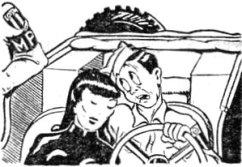
|
'JEEP GIRLS'
CHINA CRACKDOWN
CHUNGKING - (UP) - The police department here is cracking down on what the Chinese call "jeep girls," which is the Chinese equivalent of American bobbysoxers.
The "jeep girls" go to restaurants and to houses with American G.I.'s. The police have warned the girls that hereafter they must not "neck" with Americans or otherwise conduct themselves improperly.
The chief of police explained that there have been several fights recently due to G.I. attentions to "jeep girls." He said according to Chinese tradition and moral principles women are not allowed "to carry on improperly" with foreigners.
Dodson First Pilot To Land On 37 Strips
Roundup Staff Article
In the heart of Burma, 45 battle casualties anxiously awaited evacuation on an untested airstrip, bordered on one end by dense jungle, on the other by rocky mountainside.
It was a tricky situation that called for the utmost in skill from Lt. Col. G. Robert Dodson, commanding officer of a liaison group of the 10th Air Force, EAC.
To be determined was whether the small jungle airfield could accommodate the L-5's necessary to evacuate the wounded. For the 37th time, Dodson pointed the nose of his familiar "621" (donated by the city of Cleveland) at an untried landing strip. Side-slipping, the colonel successfully nursed the liaison plane to a landing. For the next two hours, he directed the clearing of the field so that other L-5's could land on their mercy missions.
Mission completed? Not yet. Airborne, the colonel made a reconnaissance flight over the enemy's lines at 350 feet, flushed two Japs and opened fire with a submachine gun as they scurried for cover.
"Dense foliage obscured results," he reported later.
SPEARHEADS ADVANCE
Dodson has spearheaded the advance of his enlisted liaison pilots behind the southward surge of combat troops. Averaging three "first" landings a week (including the first one at Lashio), he has insured swift evacuation of casualties and close ground-air co-operation.
In "621," which has flown 300 hours in some of the worst flying weather for which monsoon-time Burma is notorious, the colonel has carried such celebrities as Lord Louis Mountbatten, Lt. Gen. Dan I. Sultan, and Maj. Gen. Howard C. Davidson.
Flying sergeants and officers of one of Dodson's squadrons, the "Jungle Angels," have dubbed their genial, six-foot tall commanding officer the "Columbus of the Airways." He is no newcomer to the seat-of-the-pants school of flying, having been a member of Tex Rankin's famous aerial circus which barnstormed through the Northwest in the early 30's before joining the Army Air Forces in 1939.
VARIED SERVICE
Dodson's men sometimes fly 10 to 15 missions a day, use their tiny planes for artillery spotting, messenger service, food and supply drops, photo reconnaissance and emergency missions in which they rescue wounded air crews downed hard by the fighting lines.
During the Battle of Myitkyina, when combat planes of the 10th were plastering the besieged city with everything they had, the liaison planes even dropped captured Jap 30-pound bombs.
"But that," grins the colonel, "was more for sport than anything else."
|
BATTLE STARS
Dear Roundup: The May 3 issue of your fishwrapper contains a query from M/Sgt. McKenney on the issuance of battle stars. We would like to inform the sergeant that he shouldn't feel too badly.
Our outfit, also an air service group stationed in the wilds of Burma since early Fall 1944, has been the recipient of one battle star. Up until a very, very short time ago, our group was the only air service group serving the Burma area.
We not only serviced bomb groups, but also serviced fighter groups, ack-ack outfits, Signal air warning outfits, and many others. For this we received one battle star.
The inconveniences suffered, the pleasures gone without, the number of Jap air raids, and the physical and mental strain were worth one battle star.
But the fellows aren't moaning. They are sweating out rotation and will be happy to go home with one battle star on their theater ribbon. - SGT. HAROLD R. WINE, APO 218 (Bhamo and Myitkyina, Burma)
MORE MIAMI
Dear Roundup: In the April 26 issue of the widely-read and appreciated Roundup, a two-column spread labeled, "Miami Clip Joint Town, Say Returned CBI-ers," was printed.
This is a very true story and can be verified by thousands of other G.I.'s I am sure. I for one can verify that statement and also can add several other towns and cities throughout the States that are permitting this great injustice to be carried on by the "get-it-while-you-can" civilians against the fighting men of our nation.
It appears to me that putting that type of write-up in a paper for troops overseas is a very idiotic idea. Why remind us of the situation? Items and write-ups like that should be turned over to the War Department Public Relations Board or sent to the newspaper of the city involved. - CPL. LEO C. MILLER, Mars Task Force.
L-5's ON THE OFFENSIVE
HQ., EAC - Tiny L-5 liaison planes, armed with carbines, 45's and hand grenades, changed over
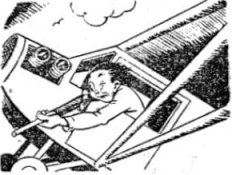
|
S/Sgt. Charles Lacy and Lt. Allen O. Pfander, in an L-5 of the 1st Air Commandos, were flying an observation mission southeast of Pegu when they saw 50 straggling Nips down below. As pilot Lacy dived low over the surprised enemy, Pfander fired on them with his carbine. This strange strafing attack continued until 14th Army units caught up with the trapped Japs.
On another occasion, three other 1st Air Commando liaison pilots - T/Sgt. John Gallagher, S/Sgts. George McLain and John Whittaker - were returning to their base when they spotted a large number of Japs. After notifying the British of their position, the L-5's circled over their prize, dropping hand grenades and firing their 45's until the British showed up.
G.I.'S DONATE FUND TO SON OF COMRADE
NORTH CHINA AIR BASE - There's a check for $1,700 en route to Mrs. Luther H. Davis, Topeka, Kans., from officers and men of "The Great Snafu Fleet," to assure the education of the infant son of T/Sgt. Luther H. Davis, recently killed in a plane crash in China.
Cpl. Ben Pearlman of Los Angeles, former commander of the Los Angeles Businessman's American Legion post, collected the fund while touring bases where "The Great Snafu Fleet" operated, supplying 14th Air Force fighter-bombers.
"Sgt. Davis was just about tops," said Pearlman. "He was NCO in charge of communications in our squadron, and when he was killed, there wasn't a man in the outfit who didn't feel it.
"Davis had a five-month-old son he'd never seen. We decided that it would be a good gesture if we all kicked in a little dough we'd otherwise booze up."
Even Super-Fortress Mascot Has His Points
XX BOMBER COMMAND BASE, INDIA - "I am paw-loose and fancy free," Col. Elmer E. Elmer, dashing "hot pilot" teddy bear who has 20 Super-Fort missions to his credit, told an ardent admirer this week in an answer to her letter.
The letter was sent to Elmira Panda, 16864 Braille St., Detroit, Mich., assuring her that there is nothing to the so-called "relationship" between him and his secretary, a honey bear from a WAC detachment.
The correspondence between Elmer and Miss Panda began when newspapers throughout the United States related heroic exploits of the colonel. Elmer, whose middle initial also stands for Elmer, is commonly referred to as "the Cotton McCarthy" by his crew on the Super-Fort Deacon's Disciple.
Elmer pilots the huge plane from the knee of Maj. Charles J. (Deacon) Miller of Dexter, Mo.
Miller, a squadron commander, found himself mysteriously in possession of the fuzzy mascot one morning after a gay evening in Great Bend, Kans.
Elmira Panda comes from the Army's Post Exchange gift service, making it an all-around wartime romance.
Elmer adjusted his command pilot wings and his fruit salad on the front of his uniform and dictated the following letter to his panda lady friend:
"My dear Elmira:
|
"I would like very much to hear from you as often as you care to write. For my part, I will try to answer whenever my duties will permit the time. There are one or two points, however, which I feel should be understood in advance.
"What are your feelings towards Mr. Frank Sinatra? I trust you are not one of the bobby socks brigade. Also I trust you do not believe the vicious propaganda about the 'Three Bears' and that blonde gold-digger, Miss Goldie (NMI) Locks. I may say they are no relatives of mine.
"About myself, since my last promotion, in addition to my duties as command pilot of Deacon's Disciples, I have been made commanding officer of 1,500 Grizzles and 500 Wombats who are attached for rations and quarters.
"My secretary is a little honey bear from the WAC detachment, but don't let this worry you. The last time I had a date with her, she chased me up a banyan tree. So I am paw-loose and fancy free. I have thrown away all my pinups and hope that you will be my pinup girl.
"May I make a request at such short acquaintance? Could you please send me a pot of Fitch's bear grease? My fur is getting rough with these Indian substitutes.
"Under separate cover, I am sending you a package of succulent young bamboo shoots, which were given to me by a rajah friend of mine. Yours sincerely, Elmer E. Elmer, Colonel, Air Corps.
"P.S. - I'll be due for rotation soon. I also have a lot of points. So keep your toes crossed and don't go hibernating around with any 4-F bears."
ON A MULE'S TAIL THROUGH BURMA WITH MARSMEN
By PFC. JOHN RANDOLPH
(The following impression of a mule pack march through the Burma jungle was written specially for the Roundup by a member of the 124th Cavalry, Mars Task Force.)
Load all your worldly goods on your back. Tighten a cartridge belt around you mid-section and hang on your two full canteens, jungle kit, trench knife, ammunition, first aid packet, etc., etc.
Sling a rifle over your shoulder. Stuff your pockets with rations and the usual pocket junk. Put that heavy steel helmet on. Grab a halter-shank with a mule tied to one end and fall out on the trail. This is how a muleskinning Marsmen started every day when he trekked 400 miles on a circuitous route from Myitkyina to Lashio.
Look ahead and you look into a mountain, Look anywhere and you look in vain for anything but mountains. Look up and you see where you are going to be. And you are going to be there. No staying in to make sick call. No chance of getting KP to keep from making the march.
Left behind and you are left in the jungles where there are, among other things, a few wandering Japs. Walking is the only way out, anyhow, so you decide to be sociable and go along with the crowd.
Up and up you go. Going down now and then is a questionable relief. Going down steep trails is no fun in itself. To make it worse, there is the mental agony of realizing that what goes down must come back up. Marsmen are convinced that it works that way in this part of the world. The only pleasant part of a march in the Burma mountains is the first two minutes of a 10-minute halt. The other eight are spent worrying about the next climb.
You wonder why you can't install escalators. You wonder how much saki the trail blazers had to drink to cut such a crazy, crooked trail that makes you walk 10 miles to go three. You wonder what the British ever wanted with Burma in the first place, why the Japs wanted to chase them out and then why we wanted to chase the Japs out in the third place.
You find yourself tagging along behind the rear end of a mule ahead of you and you wonder if he would object with a rear thrust to your midsection if you grabbed hold of his tail. It's a wonderful idea and you gingerly try it. The mule doesn't seem to object.
Your pack gets lighter. Your legs are more willing to shift one in front of the other. Your wind discards its short pants. Why didn't someone tell you about this sooner? Why doesn't basic training include mule tailing? Why didn't they develop handles for mules' tails? The Army forgets so many things.
Mules' tails kept many a man in the Mars Task Force in column. They kept many a man from the thought of being stranded in the jungle. Someday I expect to find a story entitled On a Mule's Tail Through Burma.
Ask a Marsman what he remembers best about his experiences in Burma. The battle stories will come after the march story and a No. 1 item of the march will be his mule tailing.
You do not wonder about the wonders of a mule's tail. You know it's a wonderful invention.
|
MAKES OUTSTANDING RECORD IN ASSEMBLY SUPPLY
1332 BU, ATC, ASSAM - Squadron E, assigned to this ATC Base, believes it is one of the most efficient Negro outfits in the Theater.
Under the command of Capt. William Tebay, the squadron has compiled an excellent record in its job of getting supplies ready for The Hump.
Specifically, the men are engaged in engineering, bakeries, utilities, engine modifications, plane loading, truck driving, airplane servicing and other tasks.
The unit is self-sufficient. It possesses many facilities that only larger organizations have. A dispensary, barber shop, bakery, day room, athletic grounds are among them.
The squadron mess is considered the best on the field. How to satisfy appetites is the work of Mess Sgt. Victor Knox.
"I have the best outfit over here," states 1st/Sgt. Charles E. Huff. Then he points to a recent commendation from the Base Commander for making possible increased tonnage over The Hump. He also vocally records the fact that the squadron has only had two cases of malaria since its arrival overseas.
New China WPB Ups Production In 18 Industries
CHUNGKING - (UP) - Dr. Wong Wen-hao, director of China's War Production Board, made the first report of the accomplishments of the agency Donald M. Nelson established last November. He said that decided increases were registered in 18 of the 27 principal industries, the nine others were either stationary or showed a decline.
Pig iron production, November though March, increased 20 percent; steel, 20 percent; gasoline, 30 percent; and alcohol, 30 percent.
Chungking Government spokesman P. H. Chang told the press that Leon Henderson, who recently visited China to inquire into inflation, had not made price control recommendations, but was at present studying the problem with T. V. Soong in the United States.
 Seeking to improve the efficiency of Indian mechanics under him, Capt. John T. Seigle, aircraft
maintenance training officer of the 1306th Base Unit, Karachi, has launched a campaign to teach them a working
knowledge of the English language. Each Indian mechanic, armed with a King George primer, attends class one hour
a day, six days a week, under the instruction of English-speaking Usman Shah. Seigle reports that the civilians
malum adequate English after a four-week course.
Seeking to improve the efficiency of Indian mechanics under him, Capt. John T. Seigle, aircraft
maintenance training officer of the 1306th Base Unit, Karachi, has launched a campaign to teach them a working
knowledge of the English language. Each Indian mechanic, armed with a King George primer, attends class one hour
a day, six days a week, under the instruction of English-speaking Usman Shah. Seigle reports that the civilians
malum adequate English after a four-week course.
S/Sgt. William F. Baker, veteran Signal Corps wallah in New Delhi, was scheduled to marry Miss Molly
|
STRICTLY G.I. By Ehret  HEY, BABE! YOU DROPPED YOUR HANDKERCHIEF - SIR!"
HEY, BABE! YOU DROPPED YOUR HANDKERCHIEF - SIR!"
|
Pfc. Sherwin Lando, who toils for Public Relations in the Ledo area, was given a royal reception on his first visit to New Delhi recently. As Lando stepped from the plane, a solicitous ATC passenger agent hurriedly pushed him into a waiting car, telling the driver the address of a local billet. It being late at night, Lando rushed straight to bed, pausing long enough to notice that "these are mighty sumptuous quarters for a G.I." Indeed they were. Came the dawn, he discovered that his roommate was no less than a major.
Certain little instances arise from time to time that cause us to wonder whether we're all in the same Army. An admirable example occurred this week.
The fishwrapper requires a truck to transport the paper from the "Statesman" Building every publication day. Until a week ago, Theater HQ Motor Pool, situated a scant block away, dispatched the vehicle. But with the Roundup's "transfer" to SOS, a hitch suddenly developed.
All conscience, we phoned the Theater HQ Motor Pool dispatcher as usual. We recalled the new circular on transportation. Gas, rubber, wear and tear on vehicles, conservation of time - these considerations were brought forcibly to mind. SOS Motor Pool is three miles from the Statesman. Both motor pools are in the same Army, we reasoned, and so we phoned Theater HQ transportation wallah.
The sergeant, the lieutenant and HQ Company Commander successively agreed, but they had their orders, by gum, and so all the satisfaction we got was that inner warmth of having tried to do the right thing by Uncle Sam, the taxpayers and the new circular.
But at nights we toss in our sleep dreaming of that SOS truck wantonly burning gas and rubber and gradually wearing out its innards.
New Bridge-Bopping Record?
EAC HQS. - After destroying nine enemy-held bridges in less than three months, Capt. Douglas A. Gallup of the 12th Bombardment Group believes he can claim an India-Burma record.
All of the bridges were of great importance to the Japs who were retreating from the Meiktila and Thazi areas of Central Burma eastward towards Heho and the Shan Hills.
He started his string on Jan. 24, when he knocked out a road bridge east of Thazi. On March 9 he got the road bridge at Thawatti and the Ela by-pass bridge south of Pyinmana. On March 30 he destroyed the road bridge north of Loi-Kaw towards Hopong.
On April 4, he scored against four bridges. They were the railroad bridge between Heho and Aungban, the Pinyaung Railroad bridge, the Pinyaung Road by-pass bridge and the railroad bridge at Letyin, south of Pinyaung. The Nips repaired the Pinyaung by-pass bridge but he knocked it out again.
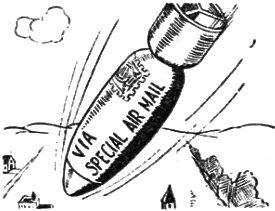
|
BUT MORALE ON THE RISE
AIR SERVICE COMMAND BASE, BURMA - For the first time in the history of this or any other war, G.I.'s are glad to see bombs fall.
A small detachment of men from "The Gremlins," ASC group, were sent to take care of a small field here. As the field did not have an all-weather landing strip and as it had been raining continually, it was impossible to get the mail in to the detachment.
Because of this, the men had received no mail for approximately three weeks. No mail, no morale.
Lt. Paul M. Dana, a squadron engineering officer, and S/Sgt. Harold R. Morris, worked out a solution to the problem.
The two took a practice bomb, packed it with excelsior for cushioning effect, wrapped the mail in waterproof paper, and placed it in the tail end of the bomb. The bomb was stenciled "mail" so that no mistake could be made.
Arrangements were made with a fighter squadron to deliver the mail. The pilot skipped the bomb on the field so that it landed directly in front of the place where the men were working.
Now the mail can be delivered to this detachment on time, and as the mail bombs fall, morale rises.
|
WASHINGTON - (ANS) - The tank carried the load as U.S. forces smashed German resistance, but it will be the doughboy and his bayonet in the Far East, the Associated Press declared this week. The news service also indicated that Gen. Joseph W. Stilwell might be given a command in the field.
War Department authorities, turning immediately from the jubilance of V-E Day to the grim business of eliminating the Japanese, informally sized up the problem this way, said AP.
Europe was tank country, and such leaders as Gen. George S. Patton were able to employ swift-moving armor in flank movements and pincer operations.
The Pacific is totally different. The islands of Japan do not lend themselves to tank warfare. It is questionable whether even the broad lands of China will provide a field day for tanks such as in Europe.
In a campaign where terrain must be overcome by the yard instead of by the mile, it is the foot-sloughing doughboy with the rifle and bayonet who must carry the burden.
The wide difference in the type of warfare ahead also brings up the question of what jobs await those tank generals who fought themselves out of a job in Europe. There has been no sign yet of future assignments for Supreme Allied Commander Dwight Eisenhower, Gen. Omar Bradley or the Patton-Hodges-Simpson trio.
There has been speculation, AP said, that the Pacific team would be a three-way affair at the top with Stilwell, now Army Ground Forces Commander, driving into China; Gen. Douglas MacArthur into Japan; and Adm. Chester Nimitz providing Navy transport and air cover.
|
ATC BASE SOMEWHERE IN INDIA - F/O Bill Atwood, who left a big league backstopping job to fly with the ATC, is serving as a C-46 pilot instructor in the pilot check-out school here.
After nine years with the Phillies and one with the Giants, Atwood entered the service at the close of the 1942 season. Stationed at Love Field, Dallas, Tex., he made hundreds of ferry trips across the U.S.A. and several trans-Atlantic flights to England and North Africa. Assigned to the ICD-ATC in December, 1944, he had completed 200 hours over "The Hump" when selected as a pilot instructor.
In his present job, he rides long hours in the co-pilot's seat while student pilots fly on instruments, shoot landings and learn emergency procedures for checking out as Hump pilots.
Atwood has been playing ball as long as he can remember - at Simmons University, Abilene, Tex., where he was a three-sport man, with Dallas, Birmingham and Baltimore before joining the Phillies in 1934.
He says that Jimmy Wilson was the smartest manager he ever played for. "It was a real heart-break for me when Jimmy's boy, Lt. Bob Wilson, was killed over here in the CBI several months ago," Atwood says. "Young Bob was a familiar sight at the old Phillies ball park in his short pants days and I know that all of the Phillies gang took his death as a personal loss."
Atwood, 33, hopes to go back into baseball after the war "if I am not too old when this thing is over."
PASS THE BUCK!
Lt. Robert L. Black, Theater Armed Forces Radio Service officer needed some buck-slips the other day to continue his business in the time-honored Army way. He turned to the obvious - the supply sergeant - for a couple hundred.
"Sorry, sir," countered the impeccable non-com, "you'll have to file a formal requisition on a buck-slip to get the buck-slips."
At last report, Black was still trying to figure out a way to get around the angle.
|
ESCAPE ROUTES OF JAPS HIT
HQ., EAC - On all the escape routes from the Irrawaddy eastward, Allied aircraft of the Eastern Air Command have been attacking the Japanese during the past week, while heavy bombers have concentrated on the narrow strip of Southern Burma still in enemy hands.
The first of these Strategic Air Force strikes was made by B-24's of the USAAF Seventh Bomb Group, which, in spite of bad weather, bombed railway jetties at Moulmein, and targets in Mergui and Tavoy.
On the following day, they attacked boat yards at Mergui, destroyed a jetty at Martaban and sank and damaged coasters and schooners at Tavoy and Mergui.
TROOPS BOMBED
During the second half of the week, RAF Liberators bombed three troop assembly areas along the Amherst Road, near Moulmein airfield, with good results. Other formations laid mines in enemy waters.
B-25's of the 12th Bomb Group, operating jointly with RAF aircraft, blasted objectives on the roads between Thazi and Toungoo, east of the Rangoon-Mandalay railroad. They bombed and strafed motor transport, troops and an enemy base, further disorganizing the harassed Japs.
EXCELLENT RESULTS
Other U.S. B-25's, co-operating with the British 14th Army farther south, attacked with excellent results stores areas and buildings at Thaton, on the Pegu-Martaban railway, and an enemy garrison nearby Ondaw, close to the Siam border, was also hit.
RAF fighter-bombers roamed all over the delta area in search of diminishing Jap targets. Mosquitoes caused extensive damage in a troop assembly area east of Pegu and attacked rivercraft and other forms of transport.
|
In Papers From Burma
By S/SGT. KARL PETERSON Roundup Staff Writer
Our ever-loving mail clerk this week dragged in, along with an assortment of beers, duns and invitations to Stateside weddings, a dirty gunnysack of captured Japanese documents and intercepted mail, sent to us from Burma by lovable old Hi Maw, a Burmese of our countenance who did a brisk business during the recent campaigns selling spirit rice and imitation rubies to both sides.
Translation of these reveals a hitherto unknown fact: During the Allied advance from Ledo and Imphal to Rangoon, our little brown enemies in Burma were not so much concerned with the loss of vital territory, the Allied air attacks or the critical supply situation as they were with the possibility of going home under the Japanese point system.
The complaint of one Jap officer in a letter to the Tokyo home office, is a case in "point."
"The men have not stolen any chickens or beat up a single villager in three days," he moans. "All they do is sit around figuring up their discharge credits. It is a sad honorable situation."
LATEST FIGURE
Other letters of Jap soldiery to the folks back home confirm this state of affairs. Save one Reizo Ishihara to his people on the slopes of Fujiyama: "Of course, Tokyo isn't saying for three days yet how many points are needed to get out, but a friend of mine in the orderly room told me 350 was the figure. I myself have only 280, but then my buddy Koishi knows a guy who got a letter from a friend in the War Office at Tokyo and he said that 300 would be enough. And down at the day room just now I was talking to another fellow who assured me that 275 was the latest unofficial figure. I regard myself as a cinch now."
In some of the envelopes are bits of scratch paper covered with figures, columns of numbers, sums and assorted "doodles." On a typical one of these is written the following: "56 months in the Army at one point is 56; 48 months overseas at two points is 96; five awards of the Emperor's star for battle service at three points is 15; no kids, damn it - total 167."
One letter is a typical Jap sugar report, addressed to a widow in Osaka by a corporal in a transportation company. "Dearest Puchie," says he, "Can we not be married very soon? I am unable to return home yet, but we might have a proxy ceremony arranged. I have long had an abiding affection for you and your two little sons, Toyama and Kaito. There comes a time in every soldiers life when he feels the family urge, the desire for little hands in his life, and so it is with me."
On the back of this missive, incidentally, is more of the peculiar arithmetic. First the sum "179," then beneath it "two at 12 points each is 24," and the total, "203."
TEA LEAF CLUSTER
Sorting through the lot we came on one tiny piece of thin rice paper which proved to be Jap "V-mail," and careful scrutiny beneath the microscope revealed it as a plaintive bleat from a captain in a QM laundry unit to his cousin in the hard-working Kobe fire department. "I just wish I had my hands on that fathead Susuki across the street who talked me out of joining the Air Corps," he writes. "Why those jokers get another Tea Leaf cluster to the Imperial Flying Cross every time they get shot down, which is often, and at six points a crack they'll have a million. They'll all be out and tossing down that good Japanside saki at those civilian bars while I'm knocking myself out over here in this stinking country. What an Army!"
Bitterness is evident in one letter from a Superior private to his wife: "I was due to come home in August on the revolving replacement plan; now all that's finished. And with only 118 points I'll be a hundred years old before I get out of the Army. If you hadn't been so proud of your damn figure I'd be a father by now and on my way home."
But the biggest find is an official memorandum, in a triple envelope marked: "Top Super Secret," which gives actual details of awarding of points. "In the Burma Theater," says paragraph Two, "Overseas credit shall be three points a month for men in the field; one point for rear echelon troops in Rangoon. Emperor's combat stars count three points each for personnel who have been shot at; one-half point for those who haven't. Final discharge will depend on Home Office policy, the war situation, shipping shortages, munitions production figures, and the discretion of unit sergeant majors."
The Roundup is a weekly newspaper of the United States Forces, published by and for the men in Burma and India, from news and pictures supplied by staff members, soldier correspondents, Army News Service and United Press. The Roundup is published Thursday of each week and is printed by The Statesman in New Delhi and Calcutta, India. Editorial matter should be sent directly to Capt. Floyd Walter, Hq., S.O.S., I.B.T., APO 885, New York, N.Y. and should arrive not later than Saturday in order to be included in that week's issue. Pictures must arrive by Friday and must be negatives or enlargements. Stories should contain full name and organization of sender. Complaints about circulation should be sent directly to Lt. Sidney R. Rose, Hq., S.O.S., I.B.T., APO 885, New York, N.Y. Units on the mailing list should make notification of any major change in personnel strength or any change of APO.

MAY 17, 1945
Original issue of India-Burma Theater Roundup shared by CBI veteran Roger Cook
Copyright © 2008 Carl Warren Weidenburner
JACK L. KNIGHT - MEDAL OF HONOR KNIGHT HILL IS TAKEN
TOP OF PAGE PRINT THIS PAGE ABOUT THIS PAGE SEND COMMENTS
PREVIOUS ISSUE CLOSE THIS WINDOW NEXT ISSUE
 LT. JACK L. KNIGHT
LT. JACK L. KNIGHT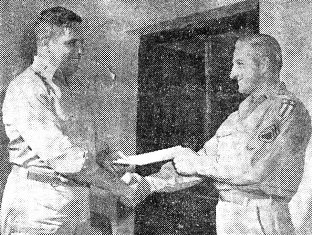 Sgt. Joseph V. Melmer was the first man in SOS to be released under the I-B Theater's temporary plan
supplementing the War Department's Readjustment Program. He is shown receiving his orders from Brig. Gen.
Gene W. Hall, SOS Chief of Staff. The sergeant, who hails from Lake Andes, S.D., doesn't seem a bit unhappy about his future prospects.
Sgt. Joseph V. Melmer was the first man in SOS to be released under the I-B Theater's temporary plan
supplementing the War Department's Readjustment Program. He is shown receiving his orders from Brig. Gen.
Gene W. Hall, SOS Chief of Staff. The sergeant, who hails from Lake Andes, S.D., doesn't seem a bit unhappy about his future prospects.

 The strange-looking contraption speeding down the Irrawaddy River is nothing more than three salvaged fighter
plane wing tanks and an improvised outboard motor. The "Nightmare," so dubbed by men of the 80th Fighter Group,
is the brainchild of S/Sgt. Romeo J. Martone.
The strange-looking contraption speeding down the Irrawaddy River is nothing more than three salvaged fighter
plane wing tanks and an improvised outboard motor. The "Nightmare," so dubbed by men of the 80th Fighter Group,
is the brainchild of S/Sgt. Romeo J. Martone.

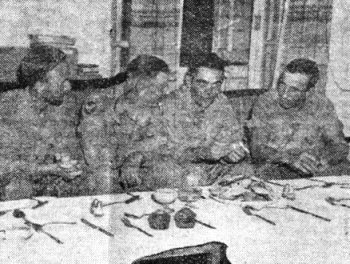 American food and a clean white tablecloth revived the spirits of these three U.S. Army officers, guests of
Maj. Gen. George E. Stratemeyer. They had just been released from a Jap prison in Rangoon. Left to right, Lt. Col.
Douglas G. Gilbert, Stratemeyer, Capt. John H. Hunt and Maj. Charles J. Lutz.
American food and a clean white tablecloth revived the spirits of these three U.S. Army officers, guests of
Maj. Gen. George E. Stratemeyer. They had just been released from a Jap prison in Rangoon. Left to right, Lt. Col.
Douglas G. Gilbert, Stratemeyer, Capt. John H. Hunt and Maj. Charles J. Lutz.
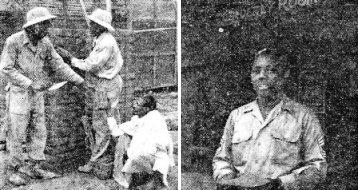 Teamwork, born of brotherly love, is displayed by the bricklaying Vaughns of Warren, Ohio - Pfc. Arthur, left
and Sgt. Otis. Mild-mannered 1st/Sgt. Charles E. Huff rules his squadron either with kid gloves or an iron hand,
whichever the occasion calls for.
Teamwork, born of brotherly love, is displayed by the bricklaying Vaughns of Warren, Ohio - Pfc. Arthur, left
and Sgt. Otis. Mild-mannered 1st/Sgt. Charles E. Huff rules his squadron either with kid gloves or an iron hand,
whichever the occasion calls for.
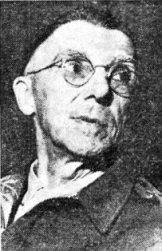
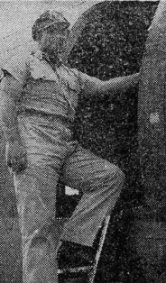
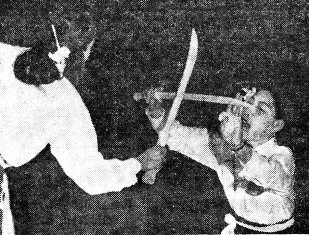 This is part of a sword dance put on by Burmese girls for personnel of the 10th Air Force, EAC, at Bhamo.
Dances were a feature of a festival staged to thank the Yanks for the part they played in chasing the Japs
from their country.
This is part of a sword dance put on by Burmese girls for personnel of the 10th Air Force, EAC, at Bhamo.
Dances were a feature of a festival staged to thank the Yanks for the part they played in chasing the Japs
from their country.
